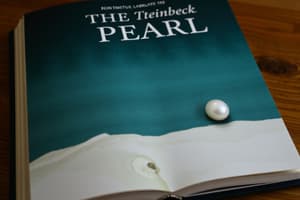Podcast
Questions and Answers
What are three details about the town that allow you to make inferences about the lifestyle of the villagers?
What are three details about the town that allow you to make inferences about the lifestyle of the villagers?
Canoes - village located on beach, villagers spend time in water, make their living on water (food, pearls); Hungry animals searching for food - food is scarce, don't have resources to care for animals, no pets; Illusion vs. Reality - they don't travel because they think life everywhere is like theirs, they know no different.
What object of great value does Kino have? Who gave it to him? From where? Why is it valuable?
What object of great value does Kino have? Who gave it to him? From where? Why is it valuable?
Kino has a canoe given to him by his grandfather, who brought it from Nayarit. It is valuable because it has been passed down from generations and is used to get food by fishing and to earn money by hunting for pearls.
How are pearls created by oysters?
How are pearls created by oysters?
When a grain of sand ends up in the folds of muscle and irritates the flesh, the flesh coats the grain with a layer of smooth cement.
Describe how Kino searched for pearls.
Describe how Kino searched for pearls.
Why do Kino's people sing songs? Give an example of a song and tell why it was sung.
Why do Kino's people sing songs? Give an example of a song and tell why it was sung.
Why does Kino want to save one particular oyster to open last?
Why does Kino want to save one particular oyster to open last?
After Kino finds the great pearl, what happens to Coyotito?
After Kino finds the great pearl, what happens to Coyotito?
Flashcards are hidden until you start studying
Study Notes
Town Lifestyle and Environment
- Canoes indicate the village is coastal; fishing and pearl diving are primary livelihoods.
- Scarcity of food highlighted by hungry animals; villagers lack resources for pets, reflecting economic struggle.
- Illusion versus reality: villagers don't travel, believing life elsewhere mirrors their own, limiting their worldview.
Kino's Valuable Canoe
- Kino possesses a canoe inherited from his grandfather, originally brought from Nayarit.
- Canoe's significance lies in its generational legacy and its role in food gathering and pearl hunting, essential for the family's survival.
Creation of Pearls
- Pearls form when sand irritates an oyster's flesh; the oyster coats the irritant with layers of nacre, resulting in a smooth pearl.
Kino's Pearl Diving Technique
- Begins with a canoe, securing a basket with ropes to a heavy stone.
- Jumps overboard with the rock tied to his ankle, allowing him to stay underwater.
- Collects oysters quickly, storing them in the basket before floating back up once finished.
- Opens oysters; if no pearl is found, the oyster is discarded.
Significance of Songs in Kino's Culture
- Songs represent both hope and strength, sung in times of struggle or joy, reflecting the villagers' emotional states.
- An example includes "the pearl that might be," expressing hope for a valuable find in the basket.
Kino's Superstitious Beliefs
- Kino decides to save one particular oyster for last, believing he glimpsed something pearl-like.
- He refrains from excessive optimism to preserve luck, aware that it may be merely a reflection.
Transformation of Coyotito
- After Kino's discovery of the great pearl, Coyotito's shoulder swelling diminishes.
- Juana perceives this improvement as a miracle, hinting at the intersection of hope and spiritual beliefs in their lives.
Studying That Suits You
Use AI to generate personalized quizzes and flashcards to suit your learning preferences.




